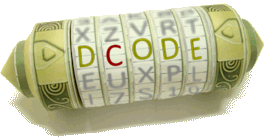Tools for frequency analysis, a cryptanalysis method studying the frequency of letters or groups of characters in a ciphered message.
Frequency Analysis - dCode
Tag(s) : Cryptanalysis
dCode is free and its tools are a valuable help in games, maths, geocaching, puzzles and problems to solve every day!
A suggestion ? a feedback ? a bug ? an idea ? Write to dCode!
Frequency Analysis
Frequency Analysis (advanced)
Answers to Questions (FAQ)
What is frequency analysis? (Definition)
Frequency analysis is the study of the distribution (and count) of the letters in a text. Analysis of frequencies helps cryptanalysis and decrypting substitution-based ciphers using the fact that some letters apparitions are varying in a given language: in English, letters E, T or A are common while Z or Q are rare.
How to use frequency analysis?
Frequency analysis generates a histogram that allows statistical distributions to be compared with those of a reference model (the plaintext language). This comparison can theoretically help decipher a text by comparing the frequencies of occurrence of letters in the encrypted message with the theoretical frequencies of occurrence of letters in the plaintext language.
Frequency analysis attack is particularly effective on monoalphabetic ciphers. These systems do not modify the statistical distribution of letters, which allows a correspondence to be established between the ciphertext and the plaintext.
To perform an alphabetic substitution using frequency analysis, the most frequent symbol must be replaced with the letter E (which is the most frequent letter in English), and the others deduced from this. This principle is only truly applicable if the cryptogram contains a large number of symbols so that the frequencies are statistically significant.
How to use frequency analysis on ngrams?
Frequency analysis is not limited to individual letters but can also be applied to groups of letters (ngrams) for polygram ciphers.
Some ciphers are characterized by the presence or absence of repeated letters in a bigram or trigram.
For some ngrams analyzes, use the sliding window mode:
Example: ABCD has bigrams AB, CD '(blocks mode)
Example: ABCD has bigrams AB, BC, CD '(sliding window mode)
When frequency analysis is useless?
If the text is too short then the statistical variations are too large and the frequency analysis is less precise.
Frequency analysis is also less relevant when the message has been encrypted with polyalphabetic encryption (which tends to randomize the frequency of the letters), or when the encryption is homophonic (several different encrypted characters for the same plain letter) or polygrammic (groups of characters replace each letter). In these cases, the analysis does not allow a decoding but allows to filter or find the type of encryption used.
What are letter appearance frequencies in English language?
Letters by frequency of appearance in English:
| E | 12.7 % | M | 2.4 % |
|---|---|---|---|
| T | 9.1 % | W | 2.4 % |
| A | 8.2 % | F | 2.2 % |
| O | 7.5 % | G | 2.0 % |
| I | 7.0 % | Y | 2.0 % |
| N | 6.7 % | P | 1.9 % |
| S | 6.3 % | B | 1.5 % |
| H | 6.1 % | V | 1.0 % |
| R | 6.0 % | K | 0.8 % |
| L | 4.0 % | J | 0.2 % |
| D | 4.3 % | X | 0.2 % |
| C | 2.8 % | Q | 0.1 % |
| U | 2.8 % | Z | 0.1 % |
For comparison purposes, here are letters frequency in French:
| E | 17.3 % | P | 3.0 % |
|---|---|---|---|
| A | 8.4 % | G | 1.3 % |
| S | 8.1 % | V | 1.3 % |
| I | 7.3 % | B | 1.1 % |
| N | 7.1 % | F | 1.1 % |
| T | 7.1 % | Q | 1.0 % |
| R | 6.6 % | H | 0.9 % |
| L | 6.0 % | X | 0.4 % |
| U | 5.7 % | J | 0.3 % |
| O | 5.3 % | Y | 0.3 % |
| D | 4.2 % | K | 0.1 % |
| C | 3.0 % | W | 0.1 % |
| M | 3.0 % | Z | 0.1 % |
Source code
dCode retains ownership of the "Frequency Analysis" source code. Any algorithm for the "Frequency Analysis" algorithm, applet or snippet or script (converter, solver, encryption / decryption, encoding / decoding, ciphering / deciphering, breaker, translator), or any "Frequency Analysis" functions (calculate, convert, solve, decrypt / encrypt, decipher / cipher, decode / encode, translate) written in any informatic language (Python, Java, PHP, C#, Javascript, Matlab, etc.) or any database download or API access for "Frequency Analysis" or any other element are not public (except explicit open source licence). Same with the download for offline use on PC, mobile, tablet, iPhone or Android app.
Reminder: dCode is an educational and teaching resource, accessible online for free and for everyone.
Cite dCode
The content of the page "Frequency Analysis" and its results may be freely copied and reused, including for commercial purposes, provided that dCode.fr is cited as the source (Creative Commons CC-BY free distribution license).
Exporting the results is free and can be done simply by clicking on the export icons ⤓ (.csv or .txt format) or ⧉ (copy and paste).
To cite dCode.fr on another website, use the link:
In a scientific article or book, the recommended bibliographic citation is: Frequency Analysis on dCode.fr [online website], retrieved on 2025-12-15,
